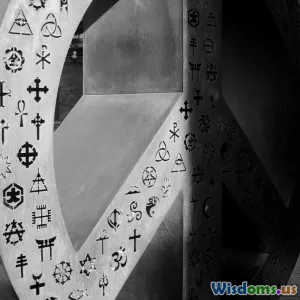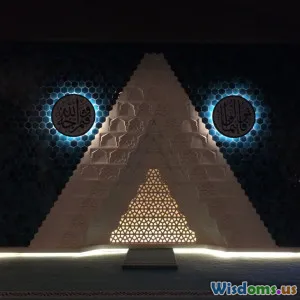
Unveiling the Hidden Power of the Flower of Life
9 min read Explore the profound significance and applications of the Flower of Life symbol in science, art, and consciousness. (0 Reviews)
Unveiling the Hidden Power of the Flower of Life
The Flower of Life is not just a captivating design — it is an ancient symbol laden with rich meaning, mystique, and profound wisdom. This intricate geometric figure consists of evenly spaced, overlapping circles that form a flower-like pattern with symmetrical structures. While it may initially appear as mere ornamentation, its influence stretches across art, spirituality, science, and modern innovation.
In this article, we embark on a journey to decode the Flower of Life: tracing its origins, examining its underlying mathematical elegance, exploring its presence in ancient cultures, and understanding its modern applications in holistic practices. Within this vibrant symbol emerges a story of universal connectivity and hidden natural laws that could inspire new ways of seeing the world — and ourselves.
Origins and Historical Significance
Ancient Roots Around the Globe
Found etched into temples in Egypt, Turkish mosques, Indian temples, and even in Mayan ruins, the Flower of Life’s global footprint marks it as one of humankind's oldest geometric patterns. The oldest known example appears in the Temple of Osiris at Abydos, Egypt, dating back at least 6,000 years. Its recurrence across different continents, separated by time and culture, highlights a shared human fascination with nature’s underlying order.
An Expression of Sacred Geometry
Sacred geometry refers to a collection of geometric symbols and shapes thought to reveal the fundamental building blocks of the universe — patterns seen in the formation of galaxies, weather phenomena, plant life, and even the human body. The Flower of Life serves as a key gateway into this world of precise symmetry and harmonic relations.
The figure is made up of 19 intersecting circles arranged so each circle’s center touches the circumference of six surrounding circles. From these overlapping circles emerge sub-patterns such as the Seed of Life, the Vesica Piscis, and the Tree of Life from Kabbalistic tradition — all holding specific esoteric meanings about creation, unity, and cosmic laws.
Mathematical and Geometric Wonders
Underlying Symmetry and Proportions
The Flower of Life exemplifies the concepts of symmetry, proportion, and repetition. Mathematicians and scientists are intrigued by how such simple components — overlapping circles — generate complex, visually balanced shapes that can be infinitely expanded.
The pattern serves as a natural demonstration of the golden ratio and Fibonacci sequence, both of which govern growth patterns in nature. For example, the spiral shells of nautilus and pinecone scales display Fibonacci sequences that resonate with the harmonious relationships the Flower of Life showcases.
Connection to Platonic Solids and Dimensional Theory
Inside the Flower of Life’s framework lie the five Platonic solids: tetrahedron, cube, octahedron, dodecahedron, and icosahedron. Platonic solids are the building blocks of three-dimensional space and relate closely to atoms and crystals. This intersection offers insight into how the symbol encapsulates spatial dimensions and the structural foundations of matter.
Researchers like Drunvalo Melchizedek popularized the visualizations of these solids within the Flower of Life to explain aspects of consciousness expansion and energy flow.
Cultural and Metaphysical Dimensions
Spiritual Significance Across Traditions
Many spiritual and esoteric traditions regard the Flower of Life as holding the blueprint of life itself — representing unity, genesis, interconnectedness, and eternal cycles. For example, in Kabbalah, the symbol is linked closely to the Tree of Life, which outlines the path to spiritual enlightenment.
Likewise, Taoist philosophy reflects similar symbolism in the flow and union of opposites represented within the pattern, portraying an eternal dance between dualities. New Age communities embrace the Flower of Life as a tool for meditation, energy work, and manifesting harmony.
Healing and Consciousness
Energy healers and practitioners of vibrational therapy often use the Flower of Life as a focal point to align body energy centers, or chakras, promoting holistic healing. The meticulous geometry is believed to emit frequencies that resonate with natural energy fields, cultivating balance and restoring vitality.
Studies in biofield science, though nascent, are exploring how geometric patterns influence human cognition and physical health. While empirical data is limited, anecdotal evidence from meditation practices shows increased mental clarity and emotional calm when engaging with sacred geometric forms.
Modern Applications and Inspiration
Art, Architecture, and Design
From Albrecht Dürer’s Renaissance engravings to contemporary digital art, the Flower of Life has inspired countless creatives. Its form lends itself beautifully to tessellation and innovative architectural layouts that combine aesthetics with structural integrity.
Modern music artists and designers embed the pattern into album artwork, fashion, and branding, indicating a continuing cultural relevance.
Technology and Scientific Exploration
The merging of traditional sacred geometry with modern science appears in quantum physics and holographic universe theories. Concepts like string theory and the formation of subatomic particles sometimes metaphorically mirror structures found in the Flower of Life.
Moreover, technological applications such as 3D modeling, nanotechnology, and fractal algorithms incorporate patterns akin to the Flower of Life to simulate natural processes efficiently.
Taking Action: Integrating the Flower of Life into Daily Life
For those intrigued, exploring the Flower of Life through creative or meditative practice offers a personal portal to profound knowledge. Start by drawing the pattern, focusing on its repeating circles, and notice how this awakens a sense of grounding and unity.
Using visualizations, placing Flower of Life symbols in your living or workspace, or engaging with related meditation soundscapes could enhance mindfulness and inspire fresh perspectives.
Artists and educators may incorporate this shape into their work to teach proportion, geometry, and the interconnectedness of systems.
Conclusion
The Flower of Life isn’t simply an ancient decor; it is a multi-dimensional language bridging science, art, spirituality, and nature itself. It reveals the hidden geometrical code that many cultures have intuitively discovered — a code that resonates deeply with the very structure of our existence.
By uncovering the depths of this potent symbol, we gain more than aesthetic appreciation; we are invited into a dialogue with the universe’s timeless laws. Whether approached through scientific exploration or metaphysical paths, the Flower of Life offers an enduring source of inspiration, discovery, and connection.
Embrace its patterns, let them expand your consciousness, and perhaps unlock new realms of understanding about life’s magnificent tapestry.
References
- Drunvalo Melchizedek, The Ancient Secret of the Flower of Life
- Robert Lawlor, Sacred Geometry: Philosophy and Practice
- Hans Jenny, Kinetic Form
- Discover magazine, studies on Fibonacci and nature
- National Geographic archives on cultural uses of sacred symbols
Rate the Post
User Reviews
Other posts in Sacred Geometry & Symbols
Popular Posts


















